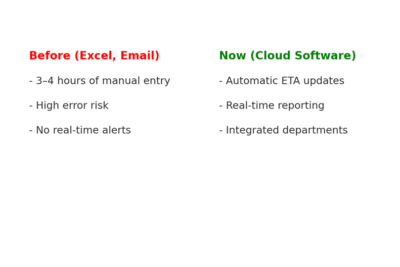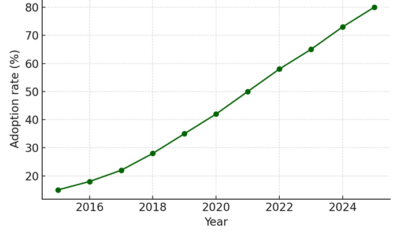In the shipping industry, Operation staff (Ops) are always caught in a dense cycle: updating ETA/ETD, monitoring bunkers, handling NOR, SOF, LOI, contacting agents, and reporting to charterers. A single small mistake can cause losses and disputes.
Previously, most of this work was done via Excel, email, and phone – error – prone, inefficient, low labor productivity, big documents storage, and difficult data retrieval, time-consuming. Now, vessel management software has become a new “weapon” that helps Ops reduce stress and improve efficiency.
From Excel to Voyage Management Software
Voyage Management Software such as Veson IMOS Platform (VIP) are changing how Ops work. Instead of manual updates, all data – from schedules, fuel costs, to P&L reports – are consolidated into a single dashboard.
For example, IMOS’s Fleet Map feature shows real-time vessel position, cargo status, and schedule. Ops don’t need to check emails or make endless calls; just opening the map provides the full picture. (Source: https://veson.com)

The Explosion of Real-Time Data Demand
A survey by Veson showed that 73% of respondents rated real-time data as extremely important, but only 44.6% believed their current systems meet this need.
(Source: https://veson.com)
This reflects reality: Ops need instant update tools to avoid being passive when vessels change schedules, bad weather occurs, or port issues arise.
AI, Big Data, and Cloud on the Rise and and becoming the main trends of the digital revolution.
Global trends in shipping indicate:
- AI / Machine Learning supports voyage forecasting and bunker optimization.
- Big Data helps analyze actual vs estimated costs.
- Cloud/SaaS enables Ops to work remotely and synchronize across offices.
- IoT collects vessel data in real time (fuel, engine, sensors).
(Source: https://www.shipium.com)
Shipping Software Market Accelerates Rapidly
According to Mordor Intelligence, the shipping software market is estimated at USD 14.26 billion in 2025, and will rise to USD 22.23 billion in 2030 with an annual growth rate (CAGR) of nearly 9.3%.
(Source: https://www.mordorintelligence.com).

This growth comes from the need to digitize logistics, optimize costs, and meet increasingly strict regulations.
Clear Benefits: From Bunker to P&L
When applying software, Ops immediately gain many practical benefits:
- Automatic allocation of bunker, charter hire, and prepayments into the voyage.
- Improved processing speed: IMOS recorded performance increases of 40% when saving voyages, 74% when opening voyage lists, and 88% when opening port schedules.
(Source: https://veson.com) - Transparent P&L reporting: showing Estimated vs Actual vs Variance, helping Ops and managers control voyage costs.
(Source: https://help.veson.com)

Digital Transformation Challenges in Vietnam
Not only globally, in Vietnam many shipping companies are still concerned:
- High implementation & licensing costs.
- Difficulties integrating with existing systems.
- Staff require training to get familiar with dashboards and data analysis.
- Scope of company’s fleet.
In addition, new environmental compliance requirements – such as EU ETS, FuelEU Maritime are forcing software to include emission measurement and carbon cost allocation features.
(Source: https://veson.com)
Ops: From “Paperwork” to “Data Experts”
In the digital era, the role of Ops goes beyond data entry and documentation. They become data analysts, supporting decision-making, risk alerts, and voyage cost optimization.
Dashboards such as Fleet Map and Voyage P&L have transformed Ops into the company’s “information hub” rather than just a “paperwork department.”
Near Future: Preparing for the Big Waves – Net Zero Cenrtuary.
In the next 3–5 years, the shipping industry will witness the expansion of:
- AI voyage forecasting, optimal calculation efficiency and support to finalize the decision making in ship operation business.
- Emission management systems
- Multi-tasking Ops on the cloud
- Cybersecurity (protecting vessel and customer data)
Companies that invest early will gain significant competitive advantages in cost, speed, and service reputation.
Conclusion: Digitalization is No Longer Optional
The global trend is clear: vessel management software is becoming the new standard.
For Ops, it is not just a tool but an opportunity to upgrade skills, move away from manual tasks, and become data-driven leaders.
If Vietnam’s shipping industry wants to keep pace with the world, it is time to leave traditional thinking behind and step onto the digital dashboard.
Chartering and Operation Department


 Tiếng Việt
Tiếng Việt